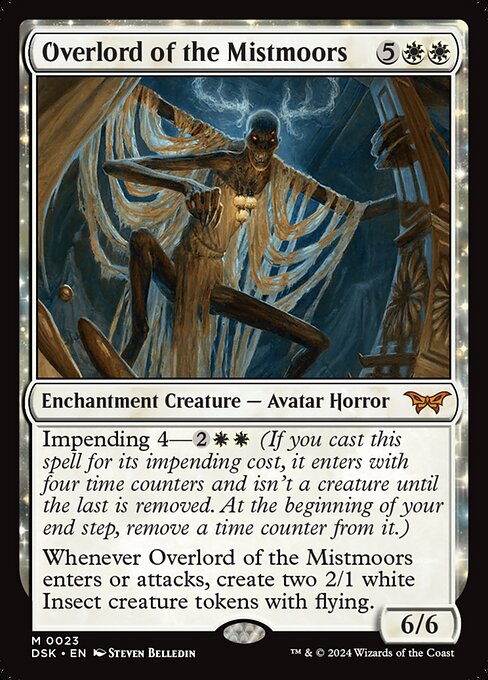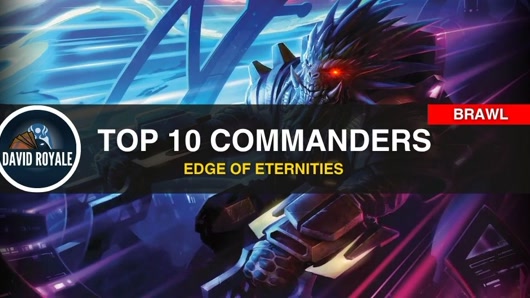Pro Tour Aetherdrift is in the books, and we have a new Standard champion—Matt Nass! He put on an incredible performance, losing only one game throughout the entire tournament.

Naturally, it’s only right that we break down the best deck in the format. Today, I’ll walk you through key strategies, general tips, and a sideboard guide to help you master this powerhouse.
Curious to see what makes this deck so strong? Let’s dive in!
Domain Overlords Standard Deck Overview
Domain Overlords in Standard is an enchantment-based deck built around Overlord of the Mistmoors and Overlord of the Hauntwoods, providing both ramp and consistent threats on the board.
While these two cards are the core of the deck, they're just tools that become even stronger when paired with key support pieces like Up the Beanstalk. That's why we're breaking down each essential component to see how it contributes to the deck's overall strategy.
Best Card Choices for Domain Overlords in Standard
Domain Overlords is not a new deck at all, as it already existed prior to the Aetherdrift release, but with it, it just got way better due to one more new addition. Can you guess which one it is? Let's see if you can figure it out!
The Creatures
Both Overlords play a crucial role in the deck. As mentioned earlier, Overlord of the Hauntwoods is essential not just for ramping but also for fixing your mana, since the lands it creates can produce any color. On the other hand, Overlord of the Mistmoors generates a steady stream of flying tokens, giving you both defensive blockers and an aggressive way to pressure your opponent's life total.
What I like about this one is that you can play it early to stall the board and cast a board wipe on your turn. At the end of it, it will become a creature that can pressure your opponent on an empty board when timed correctly.
In addition to its two powerhouse creatures, this deck runs four copies of Zur, Eternal Schemer, which fits perfectly into the strategy. It lets you play the enchantment side of your Overlords early and later transform them into creatures for just two mana. Plus, Zur's ability to grant hexproof and lifelink makes it a nightmare for aggressive decks, giving your key pieces extra protection and survivability.
The last creature in the deck is Beza, the Bounding Spring, who is there to stabilize the board when you need it the most.
As you can see, the creature package is pretty straightforward regarding its roles in the deck, so we move on to our next section.
Card Advantage
Since its release, Up the Beanstalk has been a powerhouse in decks that cast big spells for cheap, and this deck takes full advantage of it. With around 16 cards—including Overlords and removal—that trigger its draw effect, it provides consistent card advantage. While it's the main source of raw card draw, the deck also includes Atraxa, Grand Unifier and the newly introduced Stock Up to help win grindy matchups post sideboard.
The Removal
As you might notice, this deck's threats don't come online until turn three at best, which can make early aggression a problem. To handle this, it runs smart removal options like Get Lost and Ride's End—the latter synergizing perfectly with Up the Beanstalk.
Leyline Binding is even stronger here, thanks to Overlord of the Hauntwoods, whose lands have all basic types, allowing you to cast it for just one mana to exile any nonland permanent.
Of course, no control-style deck is complete without board wipes. Temporary Lockdown is great for clearing out cheap creatures as early as turn three, while Day of Judgment and Sunfall serve as panic buttons for the late game when things get out of hand.
Now, it's not hard to figure out that the card I was talking about at the beginning was Ride's End, as the deck can consistently cast removal and draw cards from it.
Optimizing Your Domain Overlords Sideboard
To better grasp each of Matt Nass's card choices, it is important to go over the thought process behind them.
Against control decks, Negate acts as a simple but effective counterspell that stops non-creature spells. It's also great for shutting down your opponent's big spells like removal, planeswalkers, or combo pieces that could mess up your game plan.
On the other hand, Elesh Norn, Mother of Machines, is a total powerhouse. She doubles your permanent triggers, which is great with the density of effects that this deck can abuse. Plus, she slows down your opponent by making their enter the battlefield effects useless, which is huge in the mirror.
Speaking of strong inclusions against the mirror, Nissa, Ascended Animist is excellent as it can come early on turn four if you ramp with the green overlord, and it's mainly used as a way to remove opposing ones, or why not; Leyline Bindings that may have exiled your creatures, making it a perfect choice against artifacts and enchantments.
Arguably, Rest in Peace is among the best, if not the best, graveyard hate cards ever printed. It exiles all graveyards, which is a huge problem for decks that rely on graveyard recursion as part of their core game plan.
Sometimes, you just need a card that can deal with small threats for little mana investment. Elspeth's Smite not only does that, but you can also use it to remove some popular cards in the format, as is the case with Mosswood Dreadknight or Enduring Curiosity, to exile them once and for all.
Speaking of effective removal and versatility, both Tear Asunder and Pawpatch Formation are great options for dealing with a variety of decks. While they're particularly useful against enchantment-heavy strategies, they can also be played against other types of cards like creatures with flying or artifacts, as needed.
Obstinate Baloth is a great creature to have around when you're facing aggressive decks like mono-red. Its big stats and life gain help you stabilize. Plus, it's perfect for dealing with planeswalkers like Liliana of the Veil, who can make you discard cards from your hand.
I've already mentioned Stock Up and Atraxa, Grand Unifier, but I want to emphasize just how solid they are against grindy matchups. They provide the extra resources you need to outvalue your opponents. I wouldn't bring Atraxa against mono-red decks, but it's definitely worth considering in slower midrange matchups that may struggle to deal with her. Even then, your opponent will still have to handle all the other threats you've got. Pro tip: If you're running Atraxa, consider pairing her with Nissa for an extra chance to hit additional card types with Atraxa's trigger.
So, these cards all work together to help Domain Overlords control the board, ramp efficiently, and outvalue opponents with card advantage and removal. They make sure you have answers for different situations and help you execute your strategy smoothly!
Tips and Tricks for Playing Domain Overlords in Standard
- While this deck has a solid curve, prioritize playing your tapped lands on turn one, especially if you don't have Up the Beanstalk to search for it early in the game. The goal is to play Up the Beanstalk on turn two, followed by Overlord of the Hauntwoods, which sets you up to cast the rest of your spells and get value from them.
- Aim to deploy Zur, Eternal Schemer once you have at least five mana and an Overlord already in play. Personally, I prefer Overlord of the Mistmoors because it's not only bigger but also leaves you with more threats after attacking, even if your opponents kill Zur in response.
- Keep in mind that opponents might try to get rid of Zur, Eternal Schemer first, then deal with your transformed enchantment right away. For this reason, I recommend going for the Zur plan once you see your opponents have low mana available.
- Also, watch your card draw triggers—Up the Beanstalk is a mandatory one. If you're not careful, you could get yourself milled or fall victim to Sheoldred, the Apocalypse triggers.
- Lastly, as I’ve mentioned before, it’s crucial to set up the board for maximum value. The goal is to bait your opponents into overcommitting and then cast your board wipe right before your Overlord is about to flip at the end of the turn. This way, you’ll be the only one with a surviving creature at the end of the turn.
Thanks for reading!




























